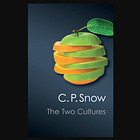John Brockman is a controversial name.
And that attention was considerably amplified when it became publicly known that his Edge Foundation was primarily funded by Jeffrey Epstein1.
Founded in 1996, the Edge Foundation is an outgrowth of the Reality Club. And ‘BuzzFeed News’ broke the news relating to the primary source of their income in 2019.
But that isn’t really the important bit. For now. No, what’s of interest is Brockman himself2. You see, in 1995, Brockman released rather the interesting book, titled ‘The Third Culture’. And yes - yes, it is.
His book is an effort to fill the gap, the third culture which CP Snow advertised for, albeit very progressively so, several decades prior.
Yes, yes, Wikipedia - I know. So here’s courtesy of the book itself3, which already on its sleeve explicitly drags in CP Snow - in addition to providing proof that this, indeed, was penned in 1995.
Keep reading with a 7-day free trial
Subscribe to The price of freedom is eternal vigilance. to keep reading this post and get 7 days of free access to the full post archives.








